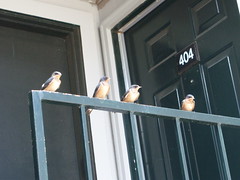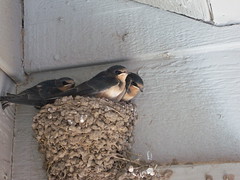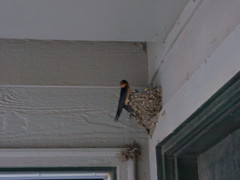When I got home last night, two of them were perched on a door frame near where the nest used to be.

Using GNU/Linux through creative laziness (and other topics as they strike my fancy)



...if you’re building small applications, CakePHP will clearly save you time in development, CodeIgniter will offer massive performance benefits, and Zend will give you a reasonable middle ground.
/etc/httpd/modsecurity.d, I saved the following in /etc/httpd/conf.d/modsecurity.conf:
LoadFile /usr/lib/libxml2.so.2
LoadModule security2_module modules/mod_security2.so
LoadModule unique_id_module modules/mod_unique_id.so
<IfModule mod_security2.c>
Include modsecurity.d/*.conf
Include modsecurity.d/optional_rules/*.conf
</Ifmodule>
/etc/httpd/modsecurity.d/modsecurity_crs_15_customrules.conf:
<Directory /path/to/wordpress/wp-admin>
SecRuleEngine Off
</Directory>
wp-admin directory by IP address, so I don't have the entire Internet hammering at the thing. Looks like blogsecurity.net has a custom mod_security configuration for Wordpress which I just haven't had time to try yet.
#!/usr/bin/perl -w
use strict;
use HTTP::Request::Common;
use LWP::UserAgent;
my $ua = LWP::UserAgent->new();
my $uri = shift @ARGV;
my $res = $ua->request( GET $uri );
print $res->content();
$ua->agent('whinerack');
my $res = $ua->request( GET $uri, accept => 'text/html' );
SecRuleEngine Off (like I did for the Wordpress wp-admin directory, which makes mod_security totally ignore that directory), you can use SecRuleEngine DetectionOnly, which makes mod_security log what it would do without actually blocking requests. This can be good for debugging.
SecRule REMOTE_ADDR "^192\.168\.1\.100$" nolog,phase:1,allow
apt-get installed the packages in parentheses as dependencies):auxil, catalogs, etc.) to /usr/share/xephem (a directory I created) and put the following in ~/.xephem/XEphem (xephem didn't seem to want to read /usr/X11R6/lib/X11/app-defaults/XEphem as the INSTALL file suggested):
XEphem.ShareDir: /usr/share/xephem
gziped the man page (xephem.1) before copying it to /usr/share/man/man1/xephem.1.gz. And I created /usr/share/doc/xephem-3.7.3/ and copied in the Copyright, INSTALL, and README files.
#!/bin/bash
apt-get update
apt-get -s upgrade
-s option lists available updates without running them unattended.apt-get instal pgkname, where pkgname is the offending package which is being "kept back."